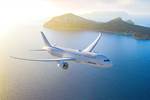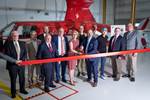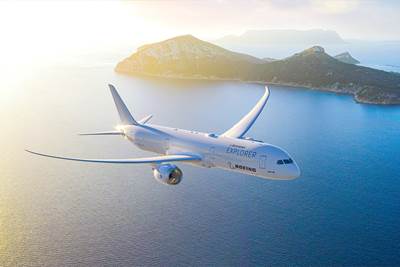Boeing TTBW concept becomes new NASA X-Plane
The X-Plane designation for Boeing’s experimental aircraft demonstrator, previously awarded under the Sustainable Flight Demonstrator project, will test designs and technologies that can be adopted into current aircraft.
The X-66A is the X-plane specifically aimed at helping the U.S. achieve the goal of net-zero greenhouse gas emissions by 2050. To build the X-66A, Boeing will work with NASA to modify an MD-90 aircraft, shortening the fuselage and replacing its wings and engines. The resulting demonstrator aircraft will have long, thin wings with engines mounted underneath and a set of aerodynamic trusses for support. Photo Credit: NAS
NASA (Washington, D.C., U.S.) and Boeing (Arlington, Va., U.S.) reported on June 12 that the aircraft produced through the agency’s Sustainable Flight Demonstrator (SFD) project has been designated by the U.S. Air Force as the X-66A.
The new X-plane seeks to inform a potential new generation of more sustainable single-aisle aircraft — the workhorse of passenger airlines around the world. Working with NASA, Boeing will build, test and fly a full-scale demonstrator aircraft with extra-long, thin wings stabilized by diagonal struts, known as a transonic truss-braced wing (TTBW) concept. CW covers the aircraft project in more detail here.
“At NASA, our eyes are not just focused on stars but also fixated on the sky. The Sustainable Flight Demonstrator builds on NASA’s world-leading efforts in aeronautics as well climate,” NASA administrator Bill Nelson says. “The X-66A will help shape the future of aviation, a new era where aircraft are greener, cleaner and quieter, and create new possibilities for the flying public and American industry alike.”
The X-66A is said to be the first X-plane specifically focused on helping the U.S. achieve the goal of net-zero aviation greenhouse gas emissions, which was articulated in the White House’s U.S. Aviation Climate Action Plan.
“To reach our goal of net-zero aviation emissions by 2050, we need transformative aircraft concepts like the ones we’re flying on the X-66A,” adds Bob Pearce, associate administrator for NASA’s Aeronautics Research Mission Directorate, who announced the designation at the American Institute of Aeronautics and Astronautics Aviation Forum in San Diego. “With this experimental aircraft, we’re aiming high to demonstrate the kinds of energy-saving, emissions-reducing technologies the aviation industry needs.”
NASA and Boeing sought the X-plane designation shortly after the agency announced the Sustainable Flight Demonstrator project award earlier this year. The Air Force confers X-plane status for development programs that set out to create revolutionary experimental aircraft configurations. The designation is for research aircraft. With few exceptions, X-planes are intended to test designs and technologies that can be adopted into other aircraft designs, not serve as prototypes for full production.
“We’re proud of this designation, because it means that the X-66A will be the next in a long line of experimental aircraft used to validate breakthrough designs that have transformed aviation,” Todd Citron, Boeing CTO, says. “With the learnings gained from design, construction and flight testing, we’ll have an opportunity to shape the future of flight and contribute to the decarbonization of aerospace.”
For the X-66A, the Air Force provided the designation for an aircraft that validates technologies for a TTBW configuration that, when combined with other advancements in propulsion systems, materials and systems architecture, could result in up to 30% less fuel consumption and reduced emissions when compared with today’s best-in-class aircraft.
“With this experimental aircraft, we’re aiming high to demonstrate the kinds of energy-saving, emissions-reducing technologies the aviation industry needs.”
Due to their heavy use, single-aisle aircraft today account for nearly half of worldwide aviation emissions. Creating designs and technologies for a more sustainable version of this type of aircraft has the potential for profound impact on emissions.
NASA’s history with the X-plane designation dates to the 1940s, when its predecessor agency, the National Advisory Committee for Aeronautics (NACA) jointly created an experimental aircraft program with the Air Force and the U.S. Navy. The X-66A is the latest in a long line of NASA X-planes (read, “Digital design, multi-material structures enable a quieter supersonic NASA X-plane”). Additionally, NASA’s Armstrong Flight Research Center in Edwards, California, has provided technical expertise and support for several additional X-planes.
For the Sustainable Flight Demonstrator, NASA has a Funded Space Act Agreement with Boeing through which the agency will invest $425 million over 7 years, while the company and its partners will contribute the remainder of the funding, estimated at about $725 million. NASA also will contribute technical expertise and facilities.
Related Content
Bio-based acrylonitrile for carbon fiber manufacture
The quest for a sustainable source of acrylonitrile for carbon fiber manufacture has made the leap from the lab to the market.
Read MoreNatural fiber composites: Growing to fit sustainability needs
Led by global and industry-wide sustainability goals, commercial interest in flax and hemp fiber-reinforced composites grows into higher-performance, higher-volume applications.
Read MoreWatch: A practical view of sustainability in composites product development
Markus Beer of Forward Engineering addresses definitions of sustainability, how to approach sustainability goals, the role of life cycle analysis (LCA) and social, environmental and governmental driving forces. Watch his “CW Tech Days: Sustainability” presentation.
Read MoreRecycling hydrogen tanks to produce automotive structural components
Voith Composites and partners develop recycling solutions for hydrogen storage tanks and manufacturing methods to produce automotive parts from the recycled materials.
Read MoreRead Next
Boeing expands ecoDemonstrator flight testing with “Explorer” airplanes
First Boeing ecoDemonstrator Explorer, a 787-10 Dreamliner, to partner with four countries on operational efficiency testing, assess 19 technologies in 2023.
Read MorePiasecki acquires former Lockheed Sikorsky facility for VTOL development
Former Heliplex facility in Coatesville, Pennsylvania, will be transformed into an R&D center for VTOL and UAS aircraft, including Piasecki’s HAXEL demonstrator and PA-890 which use composites.
Read MoreCFRP planing head: 50% less mass, 1.5 times faster rotation
Novel, modular design minimizes weight for high-precision cutting tools with faster production speeds.
Read More



























